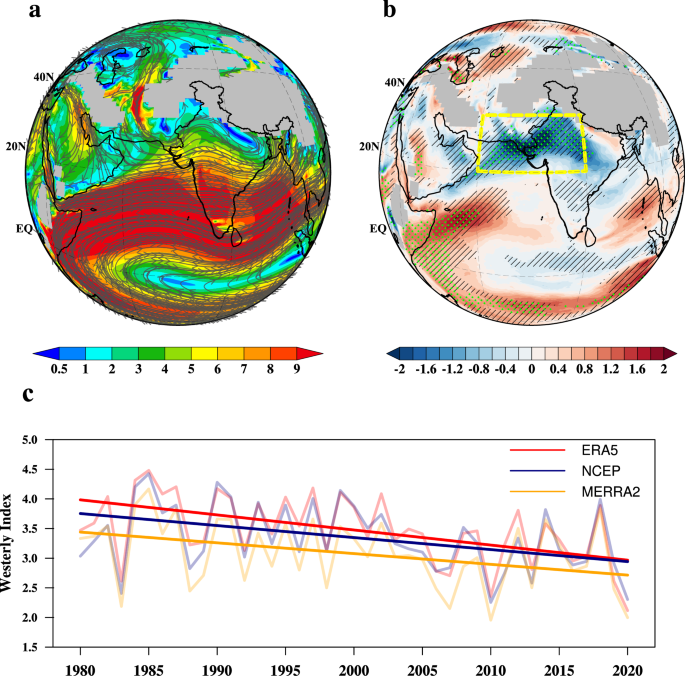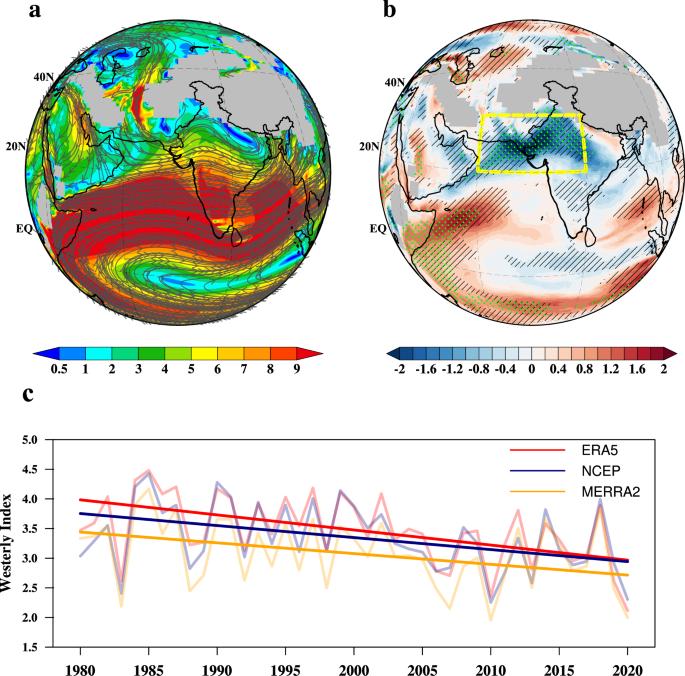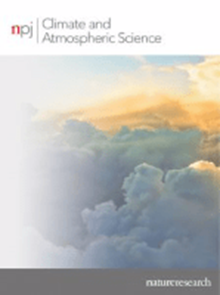南亚副热带西风近期减弱的原因是
IF 8.5
1区 地球科学
Q1 METEOROLOGY & ATMOSPHERIC SCIENCES
引用次数: 0
摘要
根据多个再分析数据集,在过去四十年(1980-2020 年)里,南亚季风槽区域盛行的夏季西风减弱了约 25%。一系列气候模型模拟的趋势表明,这种减弱是由多种人为影响因素造成的。在此期间,南亚西北部地区的海平面气压上升了 0.6-1.0 hPa,这是由于气溶胶排放以及土地利用和土地覆盖的变化造成的降温,而阿拉伯半岛的海平面气压下降则主要是由于温室气体造成的升温。温度和气压的这些变化削弱了区域气压梯度,使副热带西风从南亚转向阿拉伯半岛,并削弱了季风槽及其邻近地区的风力。风速减慢似乎导致南亚西北部半干旱地区水汽负荷异常,降雨量增加。这种减弱及其相关的区域气候变化与整个南亚的政策制定高度相关。本文章由计算机程序翻译,如有差异,请以英文原文为准。


Attributing the recent weakening of the South Asian subtropical westerlies
Over the last four decades (1980–2020), the summer westerlies that prevail in South Asia along the monsoon trough region have weakened by about 25% based on multiple reanalysis datasets. Trends in a range of climate model simulations suggest that the weakening is driven by multiple anthropogenic forcings. Over the period, sea-level pressure has increased by 0.6–1.0 hPa over South Asia’s northwestern regions, induced by cooling due to aerosol emission and changes in land use and land cover, and has decreased over the Arabian Peninsula mainly due to warming by greenhouse gases. These changes in temperature and pressure act to weaken the regional pressure gradient, deflecting the subtropical westerlies from South Asia toward the Arabian Peninsula and weakening the winds in the monsoon trough and its adjacent region. The slowing down of winds appears to result in an anomalous moisture loading and increase in rainfall over the semi-arid northwestern South Asia. This weakening and its associated changes in regional climate are highly relevant to policymaking across South Asia.
求助全文
通过发布文献求助,成功后即可免费获取论文全文。
去求助
来源期刊

npj Climate and Atmospheric Science
Earth and Planetary Sciences-Atmospheric Science
CiteScore
8.80
自引率
3.30%
发文量
87
审稿时长
21 weeks
期刊介绍:
npj Climate and Atmospheric Science is an open-access journal encompassing the relevant physical, chemical, and biological aspects of atmospheric and climate science. The journal places particular emphasis on regional studies that unveil new insights into specific localities, including examinations of local atmospheric composition, such as aerosols.
The range of topics covered by the journal includes climate dynamics, climate variability, weather and climate prediction, climate change, ocean dynamics, weather extremes, air pollution, atmospheric chemistry (including aerosols), the hydrological cycle, and atmosphere–ocean and atmosphere–land interactions. The journal welcomes studies employing a diverse array of methods, including numerical and statistical modeling, the development and application of in situ observational techniques, remote sensing, and the development or evaluation of new reanalyses.
 求助内容:
求助内容: 应助结果提醒方式:
应助结果提醒方式:


